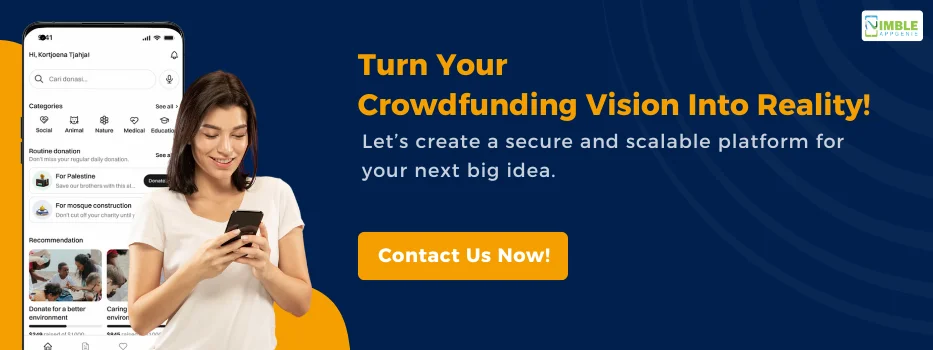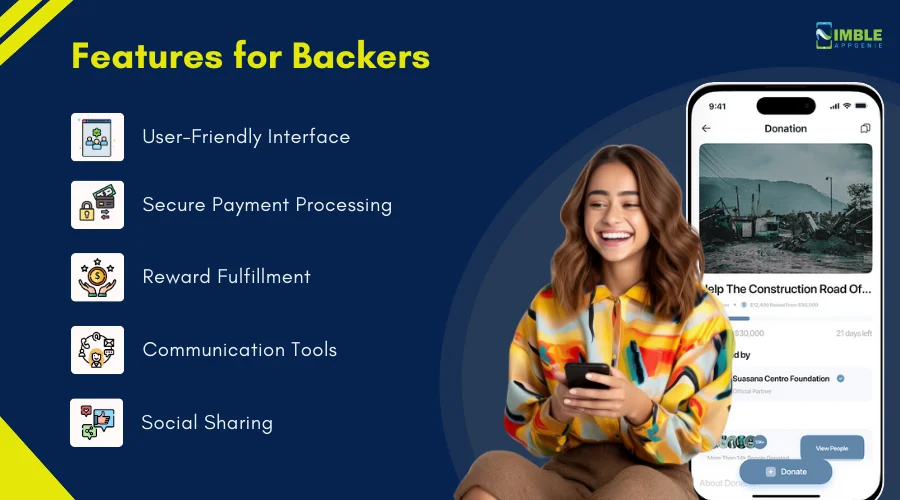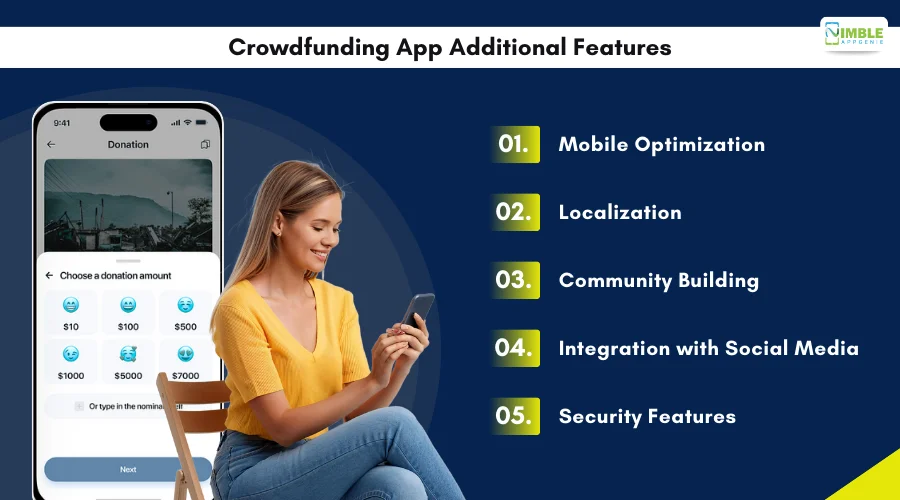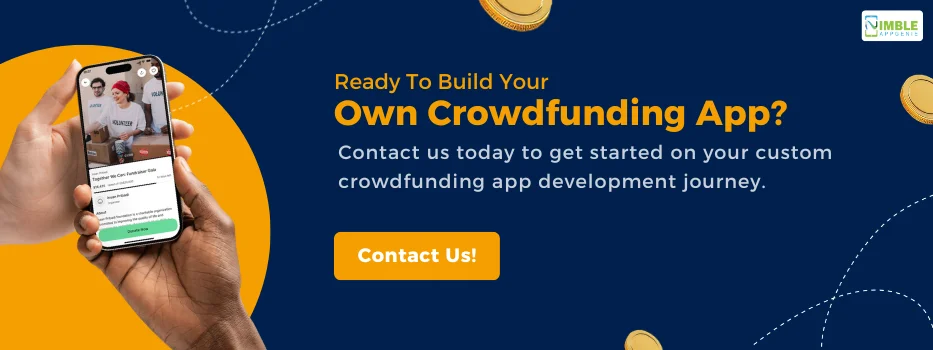Do you want to develop a crowdfunding app?
The global crowdfunding market is currently valued at around 1.60 billion USD. Here comes the good part: By the year 2032, it’s forecasted to reach 4.50 Billion USD.
That’s a 13.8% CAGR. How cool is that?
Truth be told, even without these reports and forecasts, it’s not hard to tell how important crowdfunding has become.
Over the past decades, there have been many great stars who generate capital through this.
And with time, they went on to become great companies. A personal favorite is AER. A backpacking company that started with crowdfunding.
Crowdfunding is a niche that still has a lot of potential.
But how do you make the most out of it? Well, the answer is simple, by creating a crowdfunding app.
Crowdfunding app development is a super simple process with the potential to generate huge revenue.
In this guide, we will talk about all things crowdfunding app-related.
So with that being said, let’s get right into it:
What is Crowdfunding?
To understand and create a crowdfunding app, you need to first grasp the concept of “Crowdfunding.”
The name is quite self-explanatory.
Look at it like this: You have a brilliant idea but lack the financial muscle to bring it to life.
That’s where crowdfunding comes into play.
Crowdfunding is a way of raising small amounts of money from a large number of people, typically via the Internet.
It’s a modern solution to an age-old problem of finding funding.
Instead of approaching a handful of investors or banks, project creators can appeal directly to the public. Whether you’re launching a tech product, writing a book, or even funding a medical treatment, crowdfunding helps turn visions into reality.
The beauty of crowdfunding is that it’s democratic.
Anyone can contribute, whether they’re donating $10 or $1,000. The funding goal, project timeline, and perks for contributors can all be tailored to fit the project.
Plus, it builds a community around your ideas, turning backers into supporters who want to see your success.
Ever wondered how apps like Kickstarter and GoFundMe became so popular?
It’s because crowdfunding empowers individuals to make an impact, one small contribution at a time.
How Do Crowdfunding Apps Work?
For the uninitiated, crowdfunding apps can seem a little complex.
However, they are really simple.
Crowdfunding apps act as a bridge between project creators and potential backers.
This makes it easy to create a crowdfunding app or campaign, whether it’s for a passion project, startup, or even a charitable cause.
But how does it all come together?
![How_do_Crowdfunding_Platforms_Work[1]](https://www.nimbleappgenie.com/blogs/wp-content/uploads/2024/10/How_do_Crowdfunding_Platforms_Work1.webp)
1. Project Submission
The journey starts with project creators signing up and submitting their ideas.
They provide details like project descriptions, funding goals, and timelines. Some apps may require approval, while others are more open-ended.
2. Campaign Launch
Once approved (if needed), the campaign goes live.
This is where creators can showcase their ideas using videos, images, and descriptions to attract potential backers.
It’s all about making a compelling pitch.
3. Backer Contributions
Visitors (backers) who are interested in the project can contribute money.
Depending on the type of crowdfunding app used (which we’ll get to next), backers might receive perks, equity, or even just the satisfaction of supporting a cause they believe in.
4. Fund Distribution
After reaching the funding goal, or by the end of the campaign, funds are transferred to the project creator.
Some apps allow for flexible funding, where the creator gets to keep the money even if the goal isn’t reached, while others use an all-or-nothing model.
5. Project Follow-up
Communication doesn’t stop once the funds are raised.
Project creators keep backers in the loop about progress and deliver rewards or updates on product development.
The goal of any crowdfunding app is to streamline this process by providing tools for both project creators and backers while ensuring a smooth, secure, and reliable experience.
Crowdfunding apps like Kickstarter and Indiegogo have perfected these steps, making it easier than ever to make a crowdfunding app that connects ideas with the people who want to support them.
Types of Crowdfunding App Models
So, if you are planning on going for crowdfunding app development, it’s a good idea to understand the different types.
Crowdfunding apps come in various flavors, each catering to different types of campaigns and fundraising goals.
When you decide to build a crowdfunding app, choosing the right model is crucial to its success.
Let’s dive into the most popular types of crowdfunding models:
![Types_of_Crowdfunding_App_Models[1]](https://www.nimbleappgenie.com/blogs/wp-content/uploads/2024/10/Types_of_Crowdfunding_App_Models1.webp)
♦ Donation-Based Crowdfunding
The very first model is donation-based crowdfunding.
As the name suggests, this model is all about giving for the greater good without expecting anything in return.
It’s typically used for charitable causes, medical expenses, disaster relief, and other non-profit projects.
Backers contribute simply because they believe in the cause, not because they’re getting a reward or return on investment.
If you’re looking to develop a donation-based crowdfunding app, your focus should be on ease of use, transparency, and trust-building features since users are often emotionally invested.
♦ Rewards-Based Crowdfunding
Second on the list is reward-based, which again explains itself.
This model is perfect for creators and startups who want to offer something tangible in return for contributions.
Project creators offer rewards or perks based on the backer’s level of contribution. The higher the contribution, the more valuable the reward.
Apps like Kickstarter thrive on this model.
It’s ideal for creating a rewards-based crowdfunding app where creativity can shine and backers feel appreciated for their support with exclusive perks like early access to products, limited editions, or personalized rewards.
♦ Equity-Based Crowdfunding
Want to attract investors instead of casual backers?
Equity-based models allow contributors to invest in a project or company in exchange for equity or ownership.
It’s regulated more strictly since it involves securities and financial returns.
For those looking to develop an equity-based crowdfunding app, security and compliance are key.
Potential backers need to feel safe, and the app should ensure a transparent legal process to manage investments and returns.
♦ Debt-Based Crowdfunding
Also known as peer-to-peer lending, this model allows individuals or businesses to borrow money from backers, with the promise of repaying the loan with interest. Backers are essentially investors expecting a financial return, but unlike equity-based crowdfunding, they don’t gain ownership in the company.
To create a debt-based crowdfunding apps must ease loan agreements, manage interest rates, and provide a secure, automated repayment system.
♦ Hybrid Crowdfunding
Why choose just one model when you can mix and match?
Hybrid crowdfunding combines two or more models, offering flexibility to creators and backers alike.
For instance, you might offer both equity and rewards for different tiers of backers, or combine donations with loans for non-profits seeking operational funding.
If you’re planning to build a hybrid crowdfunding app, think about how you can blend these models seamlessly, offering users the best of both worlds.
Key Features of a Successful Crowdfunding App
To create a crowdfunding app that stands out, you need to include features that make the experience seamless for both project creators and backers.
Each user has different needs, so your app should cater to them through a variety of tailored tools and functionalities.
Speaking of which, features/functionalities are as mentioned below:
► Features for Project Creators
Here are the key features for project creators in a crowdfunding app designed for managing and launching projects:
![Features_for_Project_Creators[1]](https://www.nimbleappgenie.com/blogs/wp-content/uploads/2024/10/Features_for_Project_Creators1.webp)
1. Easy Campaign Creation
A simple and intuitive campaign creation process is essential. Project creators should be able to set up their campaigns with ease, including adding descriptions, images, and videos to showcase their projects. Make sure your app guides users through every step of the setup process.
2. Flexible Funding Models
Offer different funding options, such as all-or-nothing or flexible funding, depending on the project’s needs. This flexibility can help project creators choose a model that aligns with their specific goals.
3. Payment Gateway Integration
Integrating reliable and secure crowdfunding payment gateway options is a must. Payment gateway integration also ensures that transactions are smooth and hassle-free, allowing project creators to receive funds easily and backers to contribute without any issues.
4. Campaign Management Tool
Project creators need tools to manage their campaigns efficiently. This includes tracking progress, managing rewards, and responding to backers. A strong campaign management tool can keep everything organized and on track.
5. Analytics and Reporting
Data-driven insights are invaluable. Provide creators with detailed reports and analytics on campaign performance, backer demographics, and funding trends. This will help them make informed decisions and improve future campaigns.
► Features for Backers
Here are key features for backers in an app designed to support projects (such as crowdfunding or backing projects):

6. User-Friendly Interface
A clean, intuitive interface can make all the difference. Backers should be able to easily browse projects, understand the funding goals, and contribute with just a few clicks.
7. Secure Payment Processing
Backers need assurance that their payments are processed safely. Robust crowdfunding app security features like SSL encryption and secure payment gateways will build trust and encourage contributions.
8. Reward Fulfillment
For rewards-based crowdfunding apps, managing and fulfilling rewards is key. Backers should be able to track when they’ll receive their perks, and creators should be able to update them on delivery status.
9. Communication Tools
Direct communication between project creators and backers helps build a community. Integrated messaging or comment sections allow for transparent interactions and keep backers updated on the project’s progress.
10. Social Sharing
Backers love to share the projects they support. Adding social media sharing features can help campaigns gain more visibility and attract additional backers.
► Crowdfunding App Additional Features
Here are some additional features for a crowdfunding app to enhance both the user experience for project creators and backers:

11. Mobile Optimization
In today’s mobile-first world, having a mobile crowdfunding app is essential. Ensure the app is optimized for smartphones and tablets so users can browse and contribute on the go.
12. Localization
If you plan to target a global audience, mobile app localization features such as multi-language support and currency conversion. This opens up your app to international backers.
13. Community Building
Crowdfunding is about more than just money; it’s about creating a community around a cause. Adding features that encourage community interaction, like forums or discussion boards, can keep users engaged long-term.
14. Integration with Social Media
Social media integration allows project creators to link their campaigns directly to social media platforms, driving traffic and increasing visibility. It’s a simple but effective way to expand the reach of any campaign.
15. Security Features
Financial app security is a top concern for both creators and backers. Implement two-factor authentication, encrypted data storage, and other financial app security features to protect user information and build trust.
Incorporating these key features into your app will help you develop a crowdfunding application that’s user-friendly, secure, and effective at driving success for campaigns.
Technology Stack for Crowdfunding App Development
Choosing the right technology stack is crucial when you want to develop a crowdfunding app.
The developing tech stack for a financial app defines the performance, scalability, and security of your app.
Let’s break down the essential components of a successful crowdfunding app’s technology stack:
![Technology_Stack_for_Crowdfunding_App_Development[1]](https://www.nimbleappgenie.com/blogs/wp-content/uploads/2024/10/Technology_Stack_for_Crowdfunding_App_Development1.webp)
1] Frontend Technologies
The front end is the face of your app, where users interact. A clean, intuitive user interface is key to delivering a great user experience.
- HTML5, CSS3, and JavaScript: The basic building blocks of any web app.
- React.js, Angular.js, or Vue.js: These JavaScript frameworks provide dynamic and responsive interfaces that are fast and user-friendly.
- Flutter or React Native: For mobile crowdfunding app development, these frameworks allow for cross-platform development, ensuring that your app works seamlessly on both iOS and Android.
2] Backend Technologies
The backend is the engine that powers your crowdfunding app.
This is where all the data is processed and stored, ensuring smooth transactions and functionality.
- Node.js, Ruby on Rails, or Django: These are popular backend frameworks that support fast development and handle multiple requests at once, ensuring your app remains responsive.
- Express.js: Often paired with Node.js, this framework helps manage the backend logic, making your app scalable and efficient.
- Java, .NET, or Python: Depending on your project’s needs, these programming languages offer robust performance for more complex platforms.
3] Database
Data management is the core of your app, from storing user information to processing transactions.
- MySQL, PostgreSQL, or MongoDB: These databases handle structured and unstructured data efficiently, making them perfect for storing user profiles, campaign data, and transactions.
- Redis: For caching and faster data access, Redis can be used to enhance the performance of your app.
4] Payment Gateways
Payment processing is at the heart of any crowdfunding app development.
You’ll need secure and reliable payment integrations to ensure seamless transactions between backers and project creators.
- Stripe or PayPal: Give gateways provide secure and flexible payment processing options. They support multiple currencies and transaction types, which is essential for crowdfunding apps.
- Braintree: Choice option for international payments, Braintree offers features like recurring billing and mobile payments.
- Cryptocurrency Integration: For modern crowdfunding apps, you might consider integrating cryptocurrency payments for added flexibility.
5] Cloud Hosting
Scalability and uptime are crucial for any crowdfunding app as traffic can fluctuate when campaigns go viral.
- Amazon Web Services (AWS): AWS offers cloud hosting solutions with high scalability and security, making it perfect for handling large amounts of traffic and data.
- Google Cloud: Another excellent cloud hosting provider, Google Cloud provides high availability and integration with other Google services.
- Microsoft Azure: Azure offers comprehensive cloud solutions with strong security and compliance features.
6] Mobile App Development Frameworks
If you’re planning to create a crowdfunding app that works on both Android and iOS, you’ll want to use mobile frameworks that allow for smooth cross-platform development.
- React Native: Known for its high performance and native-like feel, React Native enables faster mobile app development with a single codebase for both iOS and Android.
- Flutter: Flutter provides beautiful, fast, and compiled apps from a single codebase, making it a great choice for mobile crowdfunding app development.
Choosing the right tech stack for crowdfunding apps is about balancing performance, scalability, and user experience.
Each part plays a role in ensuring your platform runs securely, whether you’re building a rewards-based crowdfunding app, an equity-based crowdfunding app, or something in between.
Development Process for a Crowdfunding App
Developing a crowdfunding app requires careful planning, attention to detail, and a well-structured approach.
Here’s a step-by-step guide to the app development process that will help you build a crowdfunding app while covering all the necessary bases.
Let’s get right into it:
![Development_Process_for_a_Crowdfunding_App[1]](https://www.nimbleappgenie.com/blogs/wp-content/uploads/2024/10/Development_Process_for_a_Crowdfunding_App1.webp)
Step 1: Market Research and Planning
Before you dive into development, it’s essential to conduct thorough mobile app market research.
This step involves identifying your target audience, understanding your competitors, and defining your app’s unique selling proposition (USP).
Ask yourself:
- Who will use the app?
- What type of crowdfunding model will it focus on?
- What features will set it apart from existing top crowdfunding apps?
Planning also includes deciding on the app’s business model and revenue streams, such as charging a percentage of funds raised or offering premium features to project creators.
Step 2: Define Features and Technology Stack
Once the research is complete, it’s time to map out the features of the crowdfunding app.
This includes user-friendly interfaces for both project creators and backers, payment gateway integration, security features, and the ability to share campaigns on social media.
At this stage, you should also finalize the tech stack for crowdfunding apps (as outlined in the previous section) and ensure that it aligns with your app’s goals.
Step 3: UI/UX Design
The design of a crowdfunding app is crucial for keeping users engaged.
This phase focuses on creating wireframes, prototypes, and designs for the app’s interface.
The goal is to ensure the app is intuitive, easy to navigate, and visually appealing.
Your design should cater to both mobile and web users to ensure a seamless experience across all devices.
Remember, mobile optimization is a key factor in crowdfunding app development, especially as more users access apps via their smartphones.
Step 4: Development (Frontend and Backend)
This is where the actual coding happens. The development process is split into two main parts:
- Frontend Development: Using technologies like React.js or Flutter, developers create a user interface where users will interact with the platform.
- Backend Development: This involves setting up the server, database, and APIs using backend technologies such as Node.js, Django, or Ruby on Rails. This ensures that all data is processed securely and efficiently.
Throughout this stage, crowdfunding app developers also implement payment gateway integration and security features such as data encryption and two-factor authentication.
Step 5: Testing and Quality Assurance
No app is complete without thorough fintech app testing.
This stage ensures that your crowdfunding app is free from bugs, secure, and delivers a seamless experience across devices.
Testing covers functionality, usability, performance, security, and compatibility.
You should also test the payment gateway integration to ensure backers can contribute easily and securely.
A thorough quality assurance process ensures that when you launch, your app will be ready to handle real users without a hitch.
Step 6: Deployment
After successful testing, your app is ready for deployment.
This involves launching the app on app stores (for mobile apps) or going live on the web.
Deployment doesn’t just stop at launch; it also involves setting up hosting environments using services like AWS or Google Cloud to handle the app’s traffic and ensure uptime.
Step 7: Post-Launch Support and Maintenance
Once the app is live, ongoing app support and maintenance services are critical.
This includes monitoring the app for performance issues, fixing bugs that might arise post-launch, and updating the app with new features or improvements based on user feedback.
Post-launch support ensures your app remains competitive and continues to meet users’ needs as trends and technology evolve.
This structured development process, from market research to post-launch maintenance, is the blueprint for creating a successful crowdfunding app.
With that out of the way, let’s move on to the next section and discuss cost.
Cost to Develop a Crowdfunding App
When you set out to develop a crowdfunding app, the cost can vary widely depending on several factors, such as app complexity, required features, and the development team you choose.
Whether you’re building a simple donation-based app or a more advanced hybrid platform, understanding the key cost drivers is essential.
The total cost to develop a financial app can range from $30,000 to $200,000+, depending on the choices you make throughout the process.
For more details on the same, it’s highly recommended that you consult a crowdfunding app development company.
Here’s a breakdown of the main factors influencing the cost of crowdfunding app development:
| Factor | Details | Estimated Cost |
| App Complexity |
|
$30,000 – $50,000 |
|
$50,000 – $100,000 | |
|
$100,000 – $200,000+ | |
| Features and Functionality |
|
$30,000 – $50,000 |
|
$50,000 – $100,000 | |
| Technology Stack |
|
Varies based on choice |
| Development Team |
|
$15 – $200 per hour |
| Developer Location |
|
Varies by region |
| Ongoing Maintenance |
|
Ongoing (15-20% of initial cost) |
This table gives a quick yet detailed snapshot of the key cost factors.
With this out of the way, we will move on to the Challenges in Crowdfunding App Development next.
Challenges in Crowdfunding App Development
Building a successful crowdfunding app comes with its fair share of challenges.
While it’s an exciting venture, you’ll need to tackle certain obstacles head-on to ensure the app’s success.
Let’s explore the common challenges crowdfunding app developers face:
![Challenges_in_Crowdfunding_App_Development[1]](https://www.nimbleappgenie.com/blogs/wp-content/uploads/2024/10/Challenges_in_Crowdfunding_App_Development1.webp)
-
Security and Fraud Prevention
With money being exchanged online, ensuring data security and protecting users from fraud is critical.
Implementing robust security features like encryption, biometric authentication, two-factor authentication, and secure payment gateways can help safeguard transactions.
-
Compliance with Regulations
Financial compliance with regulations is a big challenge.
Different regions have their own laws governing crowdfunding, for equity-based apps.
Navigating these legal requirements and ensuring your app complies with regulations such as KYC (Know Your Customer) and AML (Anti-Money Laundering) is essential.
-
Payment Gateway Integration
Seamless crowdfunding payment gateway integration is key to ensuring smooth transactions for both project creators and backers.
However, integrating multiple payment gateways and supporting various currencies can be complex and costly.
-
User Trust and Transparency
Crowdfunding apps rely on building trust between creators and backers.
Providing transparency through clear campaign details, progress updates, and secure payment processes is necessary to gain user confidence.
-
Scalability
As your app grows and attracts more users, ensuring it can scale smoothly without performance issues is crucial.
This requires an efficient backend architecture and cloud hosting solutions like AWS or Google Cloud to handle high traffic volumes.
Addressing these challenges from the outset can help you create a crowdfunding app that’s secure, compliant, scalable, and competitive in a growing market.
Final Thoughts
Developing a successful crowdfunding app requires a strategic approach that combines innovative features, a robust technology stack, and an understanding of your target audience.
Whether you’re looking to build a crowdfunding app for donations, rewards, equity, or a hybrid model, careful planning and attention to detail are essential. By studying successful crowdfunding platforms like Kickstarter and GoFundMe, you can gain valuable insights into what makes a platform thrive.
To stand out in this competitive market, we focus on offering a user-friendly interface, secure payment gateway integration, and scalable infrastructure. Don’t forget to address key challenges such as security, compliance, and user trust right from the beginning.
Now, if you want to create such an app for yourself, it’s highly recommended that you consult a fintech app development company that can make your app into reality.
FAQs
Yes, you can. Here’s how to build your crowdfunding app:
- Market Research and Planning
- Define Features and Technology Stack
- UI/UX Design
- Development (Frontend and Backend)
- Testing and Quality Assurance
- Deployment
- Post-Launch Support and Maintenance
There are various types of crowdfunding models. These are, as mentioned below:
- Donation-Based Crowdfunding
- Rewards-Based Crowdfunding
- Equity-Based Crowdfunding
- Debt-Based Crowdfunding
- Hybrid Crowdfunding

Niketan Sharma is the CTO of Nimble AppGenie, a prominent website and mobile app development company in the USA that is delivering excellence with a commitment to boosting business growth & maximizing customer satisfaction. He is a highly motivated individual who helps SMEs and startups grow in this dynamic market with the latest technology and innovation.
Table of Contents





No Comments
Comments are closed.